Car dashboard lights play an important part in the car’s proper functioning and safety because they can indicate problems, errors, or malfunctions in certain car parts or electric and electronic issues.
The number of dashboard warning lights can be slightly different in car models. Below, we have listed over 40 dashboard lights, their meaning, and some solutions.
Before we begin, we can say that the car’s warning lights are divided most commonly into 3 main categories
Red dashboard warning lights. These error lights usually tell the driver that a safety problem or an important issue has occurred to the car and needs immediate attention.
Yellow or orange dashboard warning lights mean that a car part doesn’t function as it should and needs to be checked. Also not as urgent as a red warning light, the yellow or orange error lights usually mean that the problem can be postponed, but it’s not the case for all the issues.
Now let’s see what the most common dashboard warning lights mean and what the appropriate solution may be.
Contents
Red car dashboard lights explained
In general, red warning lights indicate a potentially serious problem or a safety issue, which, usually requires immediate attention from the driver.
1. Open trunk
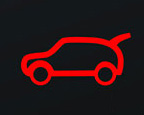
This dashboard light is on if the trunk is fully open or has not been properly closed. This sensor is prone to excessive wear due to dust, rain, and repeated openings and closures of the trunk door, it can be faulty even if the trunk is properly closed due to wear.
If you encounter this situation, try cleaning the sensor from dust and debris and see if the problem is fixed, otherwise, it’s better to replace the sensor.
2. Low fuel level in the tank
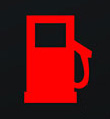
It is quite obvious what this error light means. Just refuel the tank on the first occasion when this light appears. Depending on the model of the car, the symbol warns that approximately 5-10 liters (1.32 – 2.64 gallons) of fuel have remained. For small capacity tanks, the amount left is smaller than those values.
3. Engine temperature problems

This error light indicates that the engine has reached a dangerously high temperature.
The normal temperature is between 90-110 degrees Celsius (194 – 230 F). In rare cases, it reaches a maximum of 115 or 120 degrees Celsius (239 – 248 F), especially when driving aggressively. When the temperature exceeds 120 degrees Celsius (248 F), it means that the engine overheats.
Engine overheating is one of the most common problems that you should not ignore. If this warning light is on the dash, you should stop the engine right away and quickly check the coolant tank to see if it’s empty. This is the first sign of an overheated engine.
Here are some helpful tips when dealing with an overheated engine warning light:
- Do not try to restart the engine right away. Most of the time, the engines are overheating because of the low coolant level or no coolant at all. Check the level
- Do not rush to lift the hood immediately. Most of the time, you run the risk of getting some burns if you are not careful. Let the car cool a bit and lift it slowly after some minutes have passed.
- Due to the increased temperatures, the coolant tank cap is very hot and you could burn yourself. Just wait 20-30 minutes for that.
- If it is necessary to refill with coolant, do not rush to ad it to the tank. First, make sure there are no leaks in the cooling system.
- Start the engine only after a few minutes have passed since you complete with coolant. If overheating occurs again, do not try to force it, there is a problem somewhere and you need to go to a repair shop for further invetigation preferably towed.
4. Engine oil
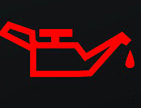
The dashboard light can have multiple reasons and meanings. Engine oil temperature may be too high, for example. Also, its level may be too low. Another option is that the oil pressure is too low. And in this case, it is advisable to stop the engine.
Red oil error light vs yellow oil error light
A red oil light usually means a problem with the oil pressure and it is advisable to pull over and stop the car. The red light can also mean problems with the oil pump, so adding more oil does not mean a good solution for this issue.
Yellow oil lamp light is a whole different story. He tells you that the oil level is below the minimum required by the manufacturer. In this case, it would be ideal to have 1 liter of extra oil, to complete the level. Then you can continue your driving.
Other reasons why the red oil light is on:
- using an oil that is not required by the car manufacturer in the owner’s manual.
- the oil is worn-out, the car has not been started for a long time, the oil filter is clogged
- faulty oil pressure sensor
- faulty oil pump
- worn or damaged bearings
5. Check engine light or malfunction indicator light (MIL)
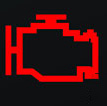
Commonly referring to engine or emission problems, this dashboard light is the one that appears most often. Also known as the “check engine”, it can mean many more faults that can be caused by different problems, and a specialized diagnosis is the only solution to detect these problems.
Common faults that can trigger the Check Engine Light to come on:
- low battery voltage;
- oxygen sensor problems (lambda probe), may need to be changed;
- the fuel cap is broken or not tight;
- bad MAP sensor;
- bad MAF sensor;
- used spark plugs;
- interrupted spark plugs wires;
- the EGR valve is clogged;
- problems with the catalytic converter, it might need to be changed;
- if it blinks, this means engine faults, respectively one of the cylinders is not working properly.
There are also cases where a “check engine” will light up after an engine start for a car that has not been started for a long time. In this case, it will switch off after some time. If it does not, you should perform a diagnosis.
6. Doors are open
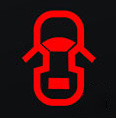
The warning light illuminates if one or more doors are open, or the doors have not been properly closed.
7. Front fog lights on

This dashboard light should be green (informative). The red color warns the driver can be fined if he’s driving with the fog lights on when there is no fog on the road. Therefore, the symbol attracts the driver’s attention.
8. Power steering problems

When this lights up, you should check the power steering fluid level, which is the more common fault. If it is indeed low, it must be completed as soon as possible.
Also, this error light can also mean that leakage might be present and you need to check as soon as possible. Adding liquid may be a temporary solution. Even if the light goes off after refilling, you should still check the issue.
If the power steering is hydraulic, the power-assisted will be deactivated as long as the light is on. You will still be able to drive, but the steering wheel will be difficult to handle. This warning light can also be yellow.
If the power steering system is electric, a simple solution is restarting the engine can sometimes turn off the warning light. But this might mean that there is an electric fault somewhere.
9. The windshield fluid level is low

As it states, this warning light is activated when the windshield liquid level is close to zero. For the light to go off, it is necessary to fill it with the windshield fluid, the appropriate one for the season. The light can also be yellow.
Worn brake pads

If this dashboard light goes on, you will need to replace the brake pads, which are too worn. Another possibility is that the sensor is faulty. Also, you can take into account potential problems with the brake fluid, it’s worn and needs to be changed, meaning there is too much water in it, or it’s below the required level.
Problems with the car start-up system

The ignition of this error light means that the electronic immobilizer or another component of the starter system is malfunctioning. It can come from a key left without a battery for the remote control or from a more complex fault.
The key battery is low

When this light comes on, you need to replace the key battery. Not all cars have this, so there will be cases where you will have to figure out the problem yourself.
Problems with the towing system

In most cases, this means problems with the towing hook. the most common one is that it has been installed incorrectly.
The hood is open

This dashboard light is on if the car hood is open. In this situation, just stop and close the hood because so you are out of risk. If it doesn’t close, improvise a solution that keeps the hood down and avoid the risks involved.
Problems with air suspension

This symbol may indicate several problems with the air suspension, such as air leakage or sensor malfunctions. To identify the error accurately, you must use an OBD diagnose.
Lane assist

This lights up to attract the driver’s attention that the car is no longer properly placed in its lane.
Oxygen sensor malfunctions

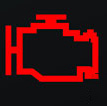
If this error is lit, the ECU may limit the maximum power of the engine. This dashboard light is rather new, bad oxygen sensors usually trigger the check engine light.
Check this article for more complex information about a bad oxygen sensor
The seat belt is not attached

This light is on if the driver or front passenger does not have the seat belt attached, while the car is moving. The light signal is accompanied by an acoustic signal usually very noisy and the only solution is to put the seatbelt on.
Warning about the distance from another vehicle
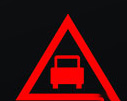
If the distance from another vehicle is below the minimum safety limit, this dashboard light means a risk of a collision. In most cases, the visual warning is accompanied by an audible warning.
The parking brake is engaged

If this warning light is on, it means that the parking brake is in the “On” position. This is accompanied by another light, usually by the brake pad wear that may indicate a malfunction in the braking system.
Battery or alternator problems

This error symbol always lights up when the car is started, if it disappears after a few seconds, then it’s nothing to worry about. If it remains on, this may suggest that there is a problem with the battery, alternator, or connecting cables.
You will risk losing power if you see that this dashboard light stays on. Most of the time, you have a very weak battery at that time, a faulty charging relay, or an alternator with a serious malfunction.
Check this article to see more information about alternator problems
Braking system

This light is on when the handbrake is engaged, but it can also you about other braking problems. For example, a malfunction of the brake pedal or a low level of the brake fluid. It may also mean other possible faults of the braking system, but this depends on the car model.
Problems with airbags

The warning symbol lights up if the airbag is either deactivated or not functioning properly. In the second situation, there is a risk that the airbag is triggered without a reason or, on the contrary, it may not open in the event of an accident.
ABS (Anti-lock Braking System) Warning

If there is a fault with the ABS, the driver may lose control of the car each time the brake pedal is pressed. In the easiest case, the error could only concern the ABS sensors, not the system itself.
However, you should check this issue right away. In the col season, some cars may have the ABS light on if they have frozen ABS sensors or if the wheel or floor has enough snow and ice that could affect the system. The ABS might not work at all if this dashboard light is on.
Water in the fuel filter

As soon as this symbol appears, the engine must be turned off. The next step is to drain the water from the filter or, if that is not possible, replace the filter.
Yellow car dashboard lights
Yellow or orange dashboard lights indicate malfunctions or failures that are not as dangerous as the red light warning lights. Some errors can go away by themselves or can be repaired easily, for others, though, you will have to go to a repair shop.
Stability control system

This symbol refers to traction control. In general, the indicator blinks when the car is moving on a low grip surface, such as an icy road, and remains constantly lit when the system is deactivated or faulty. In the second case, it is recommended to check it using an OBD scanner.
The most common reasons that can trigger the control panel responsible for the traction system
- The wheel speed sensors are faulty
- A faulty sensor at the steering angle
- Poor road conditions, which I’ve talked about earlier
- Steering column problems
- Software problems
Warning about convertible ceiling

In this case, the automatic convertible system is not working properly or has encountered a problem during the opening or closing process, and you are not permitted to exceed the manufacturer’s speed limit.
Typically, the maximum possible speed for a convertible with the roof being capped is 30 mph, but many models need to run slower during operation.
Rain sensor

If this sensor illuminates in the dashboard, it means that it is not operating at optimal settings. To diagnose the issue, you should ideally use an OBD scanner.
You should visit the service

This symbol tells the driver to schedule a service check. Most often because it’s time for periodical changes of the oil and filter, but an OBD diagnosis is often required to explain why this dashboard light is on.
Adaptive headlights

Problems with the adaptive headlights system can take many forms. These are described in detail in the car’s technical manual. Check first to see if the dedicated sensor is covered by dirt or snow.
Airbag deactivated

The dashboard light confirms that the airbag has been voluntarily deactivated.
Slope descent assistance system

This indicator lights up when the “Assisted slope descent” function is activated.
Diesel particulate filter warning

This symbol lights up when the diesel particulate filter regeneration has not been performed under optimal conditions. In this situation, it is recommended to travel at a constant speed, usually at about 3000 RPM, over a distance of several miles.
More information about diesel particulate filters.
Press the clutch pedal

This dashboard light tells the driver to press the clutch pedal to start the engine.
A burnt brake bulb or a burnt bulb on the rear

This dashboard light may refer to a burnt bulb on headlights, lamps, signaling, or any other bulb. If the indicator is on, you need to identify the compromised bulb and replace it.
The key is not in the car

You’ll see this dashboard light in cars with keyless go feature, this symbol warns you that it does not detect the presence of the key. It is not possible to start the engine until the key is detected and stopping it under these conditions will not be followed by a restart until it the key is detected.
Low tire pressure

Also known as the “Tire Pressure Monitoring System” (TPMS), this symbol reports that one or more tires have pressure below the recommended level.
There is also the chance that the error will be an electronic one, in the sense that a system sensor is no longer functioning properly.
Even if the TPMS sensor icon differs from the one in the image above, sometimes it shows like that.
Read this article for more information on Tire Pressure Monitoring System
Problems with the light sensor

If there is a malfunction in this system, the headlights must be switched on manually.
Spark Plugs / Preheat Warning

Present mostly on diesel engines cars, this light can indicate both a spark plug problem and a brake pedal contact failure or problems with the exhaust/pressure and temperature sensor. There is also the possibility of a problem with the spark plug relay.
Low-temperature warning

The indicator starts when the outside temperature approaches 0 °C (32 °F). It may appear when temperatures drop below 4 °C or 39 °F due to the risk of ice forming on the road.
